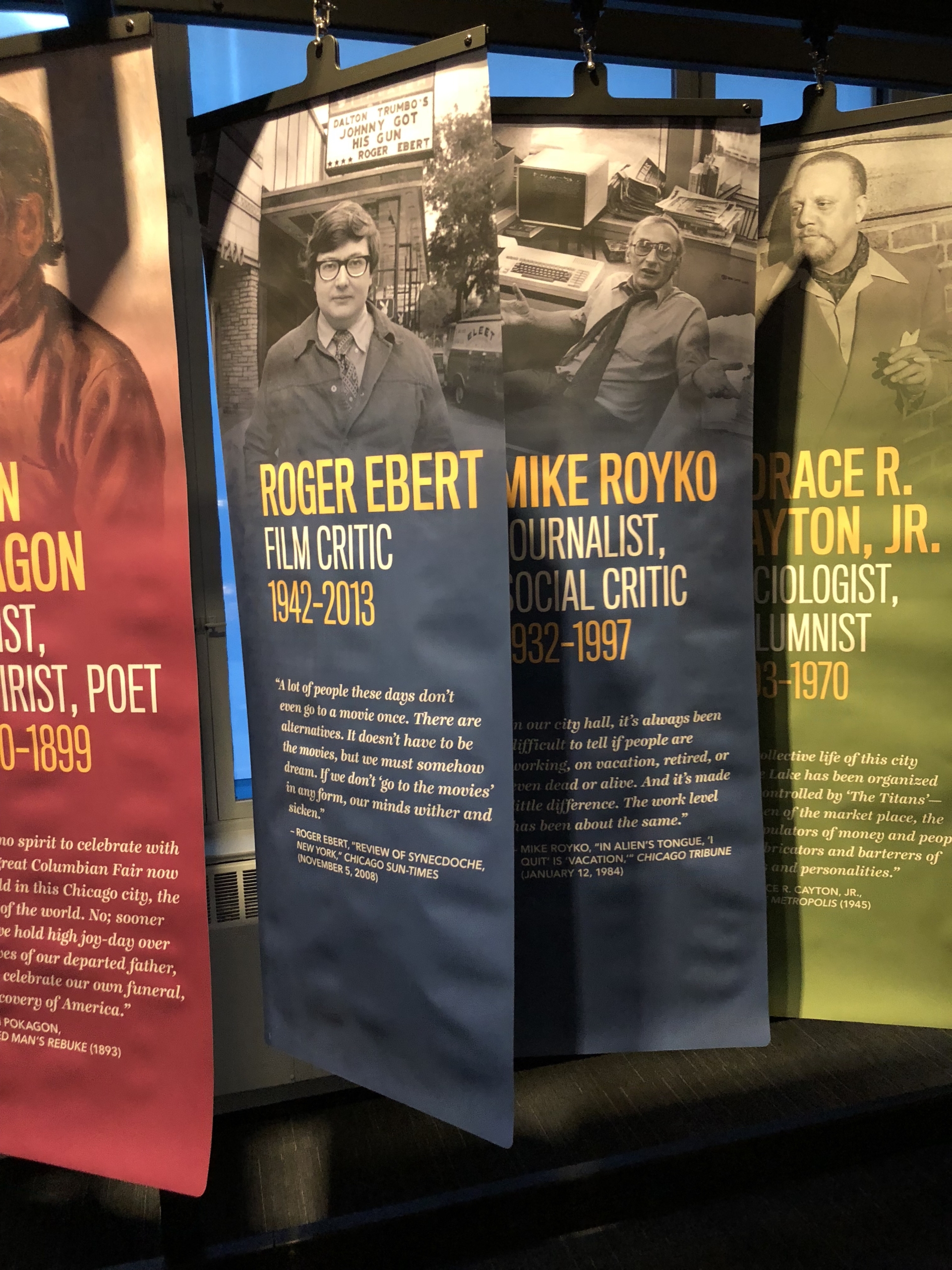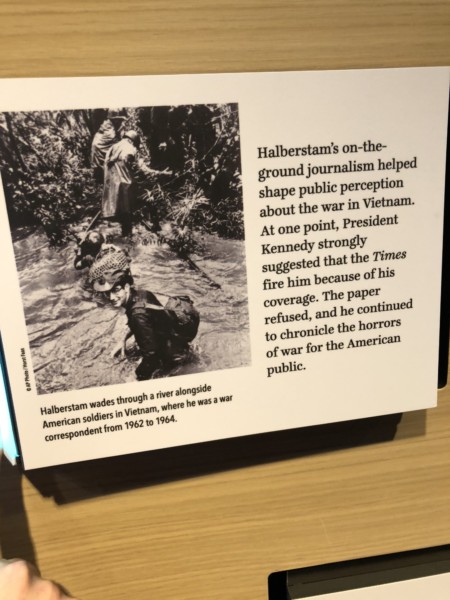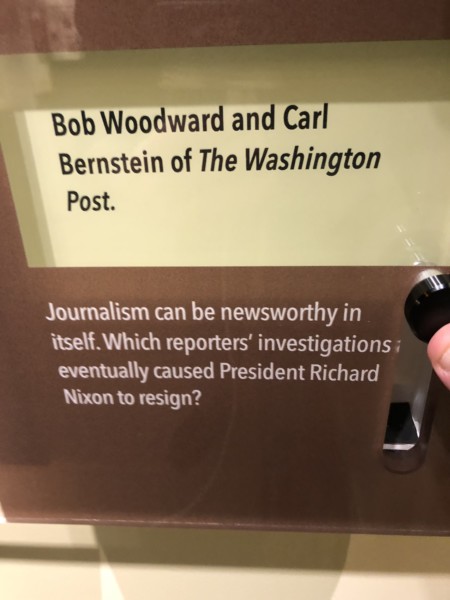A place for journalism was never a foregone conclusion at a new museum that celebrates the nation’s best and most important authors. Journalism, after all, is either the first or the rough draft of history, and either adage implies a lack of the polish, foresight, skill, and self-awareness that makes for great literature.
At the newly opened American Writers Museum in Chicago, though, journalists are integrated in both obvious and unexpected ways. The obvious players, of course, include the journalists like Mark Twain, Ernest Hemingway, and Ben Hecht who became great novelists, and the likes of Ida B. Wells, David Halberstam, and Hunter S. Thompson, whose nonfiction impacted both society and the craft of writing.
The unexpected part is how much further into the history of mass communication the AWM delves. In one gallery that explains the evolution of the publishing industry writ large, there are sections tracing journalism from such Colonial-era enterprises as Andrew Bradford’s American Magazine and Benjamin Franklin’s General Magazine on through to the impact of the Saturday Evening Post and the 20th-century advent of specialty periodicals like Seventeen and Time. A section on “Voices of Dissent” drills deeper, tying the publication of Thomas Paine’s polemic Common Sense to the launch of the Chicago Defender and, eventually, the LGBT press. A dog-eared copy of the 2016 Best American Magazine Writing sits beside this history, placing work from ProPublica, the Intercept, and Buzzfeed into the continuum.
TRENDING: He played a monster hand of access journalism poker
Likewise, a section provides a timeline for US newspaper publishing, starting from the 1704 debut of the Boston News-Letter and ending with a section about the Seattle Post-Intelligencer’s 2009 decision to go online only. “With increased competition from radio, television and the Internet, many newspapers have shut down or gone digital,” the rubric explains.
Indeed, the history of journalism and veneration for some of its greatest practitioners laces the 11,000-square-foot museum, which opened in May on the second floor of an office building on North Michigan Avenue. About 20,000 visitors have stopped in—tickets are $12 for adults, $8 for students and seniors, free for kids under 12—boosted in part by Fodor’s placing it atop its list of the world’s 10 best new museums and USA Today readers voting it the best Illinois attraction. The museum founders raised $10 million, which pays for the exhibits and three years of operating expenses, including rent.
“The decision was made that there wasn’t going to be a distinction here, that we were just going to celebrate writers,” says Carey Cranston, the AWM’s inaugural president. “That’s going to include fiction and nonfiction, and as soon as you do that you have to include journalists because they’re the backbone of who we are as a nation as far as the written word goes. It’s something that has to be acknowledged.”
Within steps of the AWM ticket desk, the institution’s regard for the value of journalism is established, at least for now, in a temporary exhibit of framed images of a who’s who of the 20th century literary canon as shot by legendary photojournalist Art Shay. And while the subjects for the veteran of Life, Time, and Sports Illustrated are dominated by those conventionally regarded as the most respected and impactful book authors of their age, they also include columnist Mike Royko posing in the Chicago Tribune newsroom, Washington Post humorist Art Buchwald about to tuck into a carrot cake, and Ebony and Jet founder John H. Johnson in the groundbreaking periodical’s Michigan Avenue office. At the far end of the gallery, an array of Shay’s news photography is posted on a whiteboard where a sign invites visitors to write their own captions. “Copywriters can amplify the impact of a photo,” it explains.
ICYMI: Twitter shouldn’t ban Donald Trump
Elsewhere in the permanent sections of the museum, trivia questions test visitors’ knowledge of journalistic history from Joseph Pulitzer to Watergate. Some tidbits were surprising; it would appear to be a little-known fact, given the whinging about the decline of the print media industry, that “in 2011, Americans could choose from among 13,000 newspapers—the same as the 1890s.” (It was unclear how the museum defined newspapers in that factoid.)
In a large room devoted to regaling hundreds of groundbreakers, journalists are again well represented, from the barrier-busting war correspondent Martha Gellhorn to the Jewish Forward founder Abraham Cahan. The decisions about who would be in and out resulted from nearly three years of debate among the seven-person Content Leadership Team that included Library of America publisher Max Rudin, himself a freelance journalist, and Donna Seaman, senior editor of Booklist. They took input from about 40 “subject matter experts” including The New Yorker’s Jill Lepore, NPR and Washington Post book critic Maureen Corrigan, and The New York Times Puzzle Editor Will Shortz. Corrigan and New Yorker staff writer Adam Gopnik are on the AWM’s National Advisory Council.
“If there’s a fiction writer who’s not up on the wall, they might have been up there because somebody argued very vehemently for Abraham Cahan to be up in the American Voices exhibit,” Cranston says. “There definitely had to be a balance. That balance was at the core of any of arguments.”
Still, the AWM is decidedly not attempting to duplicate the comprehensive nature of Washington DC’s Newseum, Cranston says. Rather, the interest was focused on ways in which journalism “really broadens the definition of what it means to be a writer.”
“The nature of what it means to be a journalist is a broad concept,” Cranston says. “It’s folks like Hemingway, whose journalistic tendencies come into their fiction, and reviewers like Roger Ebert whose work helps explore criticism’s role in journalism. How does sportswriting fit? What does that mean to writing and the art of writing? Those are the questions we’re asking.”
ICYMI: 10 resolutions for newsroom managers
Steve Friess is a freelance journalist based in Ann Arbor and a journalism instructor at Michigan State University. Follow him at @SteveFriess.



